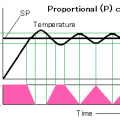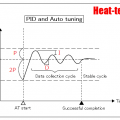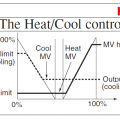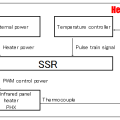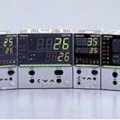INDEX
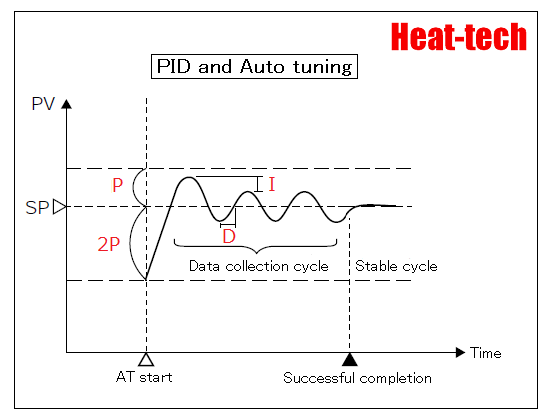
Proportional control is divided into three types, time proportional control, continuous proportional control, and position proportional control, depending on the heating method.
①Time proportional control (switching control)
◎ Time proportional control is a control that finely changes the ratio of ON and OFF time (duty ratio) in proportion to the deviation from the set value in the proportional band centered on the set value.
In proportional control, the manipulated variables must be able to change continuously.
However, when using electrical quantities such as voltage and current as the manipulated variables, ON / OFF by switching can be easily realized, but it is not good to change continuously.
For this reason, a method is used in which pseudo-continuous changes are made while actually being ON / OFF. A method called switching control
In switching control, the manipulated variables are ON / OFF pulse trains.
For a waveform that repeats ON / OFF, the duty ratio is the ratio of the ON time to the repetition period.
Duty is an analog quantity.
And when this repetition frequency is high enough, switching can be ignored and can be considered as continuous control.
Switching pulses can be approximated as analog quantities, and by using switching control, continuous proportional control can be achieved.
◎ One cycle of ON and OFF is constant, and this time is called control cycle. Assuming that 1 second is set, the output from the controller will always be ON if the current value is in the lower range than the proportional band.
If the current value is higher than the proportional band, the output from the controller is always OFF.
In the proportional band, the ON / OFF time ratio changes in proportion to the deviation from the set value depending on the temperature.
For example, if the current value is lower than the set value and the ON time is 0.7 seconds, the OFF time will be 0.3 seconds and the ON time will be longer.
When the current value reaches the set value, ON time and OFF time are both 0.5 seconds, the same.
Let’s compare time proportional control and ON-OFF control. Taking the electric heater control as an example, in the case of ON-OFF control, the electric heater switches between the ON point and the OFF point (set value), so the amount of overshoot due to detection delay etc. will increase.
On the other hand, the time proportional method changes the ON / OFF time ratio according to the deviation from the set value when the current value falls within the proportional band. Overshoot is small.
In time-proportional control, the shorter the control cycle, the more important the element for obtaining good results.
For time proportional control, use the voltage output and combine it with the SSR of the contactless relay.
With SDC15, it is as short as 0.5 seconds, and good control results can be obtained.
② Continuous proportional control
Continuous proportional control means that the controller outputs 4 to 20 mA or 1 to 5 V continuously according to the deviation between the current value and the set value, and inputs it to the operating device. To control continuously.
For example, for 4-20mA output,
4mA→0V
12mA→50V
20mA→100V
And control current value to control output voltage value.
Since the output voltage can be supplied continuously without interruption, stable control with little load on the heater can be performed.
③ Position proportional control
Position proportional control, like time proportional control and continuous proportional control, refers to a control operation that operates with a manipulated variable proportional to the difference between the current value and the set value and the deviation, and opens and closes the electric control valve with the relay output of the controller. It controls gas and heavy oil combustion furnaces and blower dampers.
For example, suppose that the set temperature is set to 700℃ and the proportional band is set to the set value ± 100℃ (600 to 800℃).
When the temperature detected by the thermocouple is in the temperature range lower than the proportional band (600℃ or less), the motor opening of the electric control valve becomes 100% (fully open).
When the detected temperature exceeds 600℃ and enters the proportional band, the manipulated variable works in proportion to the deviation.
When the detected temperature is 650℃, the motor opening is 75%, and when the detected temperature has just reached the set value, there is no deviation and the motor opening is 50%.
Further, when the detected temperature exceeds the set temperature and rises, the motor opening gradually closes, and when it exceeds the upper limit of the proportional band of 800 ° C, the motor opening becomes 0% (fully closed).
Generally, the motor opening rotates in the range of 0 to 160 °, and when the operation amount is 50%, the motor opening is 80 °.
Also, the control accuracy differs depending on the magnitude of the proportional band.The smaller the value, the more frequently the motor opens and closes, and the better the control accuracy. User. Conversely, if the proportional band is set too large, the motor will not operate unless the temperature changes significantly, resulting in poor control accuracy.
The three types of proportional control methods, time proportional, continuous proportional, and position proportional, are used depending on the control method and the desired control result. Generally, continuous proportional control is the most accurate.
Loss occurs when the electric quantity is reduced by analog operation.
When a transistor is used in analog operation, a voltage is applied to both ends of the transistor, and the transistor consumes power.
And all of this loss is heat, which is accompanied by significant heat generation.
Switching operation does not reduce the loss to zero, but it can reduce the loss significantly compared to analog operation.
Therefore, it produces less heat. This is the most important feature of switching control.
In the past, relays (electromagnetic switches) were used as switching elements, making high-speed switching impossible. When high-speed, precise control is required, switches cannot be used, so pneumatic or hydraulic pressure was used for the operation unit.
However, recently, various high-speed, large-capacity semiconductor switches such as transistors, thyristors, power MOSFETs, and IGBTs can be used. With this switching control technology, control using electricity as a manipulated variable has developed rapidly.
A major factor in recent advances in control technology has been the ability to easily and inexpensively perform advanced control calculations using microcomputers.
However, not only microcomputers, but also the development of such an operation unit is extremely large.
Switching control is often used for motor control.
 HEAT-TECH Best Technology Online Shop
HEAT-TECH Best Technology Online Shop 


